The KKK Comes to Palo Alto
Before the advent of movies, radio, and television, our country was more dispersed in a psychological sense. The mass media has given Americans a common experience, a shared culture, a common reference point. In our history shared experiences have brought the country together — watching men walk on the moon, listening to Fireside Chats, cheering on Olympians, even shared knowledge about The Simpsons. But the mass media has also been used to rally hate and intolerance (McCarthyism, Father Coughlin, George Wallace). One of the earliest and most despicable cultural phenomena driven by the mass media was the rise of the Ku Klux Klan. Before radio or TV, the silent movie was the nation’s most important cultural media experience and a 1915 film would prove just how important the movies could be.
Although the Klan had its first life in the years following the Civil War, the KKK basically died out with the end of Reconstruction. Years later, the resurrection of the Klan was actually inspired by D.W. Griffith’s Birth of a Nation, a three-hour film based on Reverend Thomas Dixon’s book The Clansman. Birth of a Nation painted a mythological, romanticized version of the original Ku Klux Klan. In the movie, the virtue of Southern Women is rescued by the Klan from leering, sexually animalistic black men — actually white actors in in blackface). The film is saturated with the worst sort of racial stereotyping and bigotry — black legislators take off their shoes and socks and eat fried chicken maniacally in the state legislature, for instance. While many of the iconic images we now associate with the Klan such as white sheets and burning crosses were actually invented for the film on a Hollywood sound stage.
The film was controversial from the start. In Boston, Philadelphia and other northern cities, race riots began after the film seemed to cast a spell on some northern whites. One white man in Lafayette, Indiana killed a black teenager after seeing the movie. The newly formed NAACP condemned the film as “three miles of filth” and helped get Birth of a Nation banned completely in cities such as Chicago, Denver, St. Louis, Pittsburgh, and Kansas City. But in the South, where a white population still harbored deep resentment over Reconstruction, the film’s imagery caught fire.
Soon a new Klan was on the march. In the late teens, membership skyrocketed toward six million — or one quarter of the eligible male population in the United States. And it was not just blacks that were subjected to the Klan’s terror. Catholics, Jews, and immigrants were also on the KKK’s hit list. As the group gained in political power and took control of state governments in Tennessee, Indiana, and Oklahoma, Klan leaders attempted to spread their message to new parts of the country. In 1923, the KKK headed for Palo Alto.
Initial Klan activity in Palo Alto came from a Texas engineering graduate student at Stanford University named Robert Burnett. A 1923 article appearing in the Palo Alto Times, reported on Burnett’s desire to organize a local chapter of the KKK. By 1924, two groups had been formed — one at Stanford, including at least seven faculty members — and another in Palo Alto, said to represent a wide array of local businessmen. A women’s branch comprising more than fifty members was established later that year. And although it’s hard to imagine today, the Klan was not shy about making public appearances in Palo Alto. In August of 1924, for instance, robed Klansmen, defiantly perched in the open backseats of fifteen automobiles, were led by the Oakland Klan Band in a march down Alma Street and Hamilton Avenue. The event was witnessed by several hundred Palo Altans. In March of that year, hooded Klansmen burned fiery crosses and initiated 31 new members in a ceremony near Pitman and Katherine Streets, witnessed by some 500 spectators.
The Klan also seems to have had some political power in town. Police Chief Chester F. Noble accused the Klan of being behind a residential committee’s effort to bring him down on charges of corruption. Responding to accusations of pocketing police money for personal use, Noble told reporters, “I know positively that this is merely a Klan fight against me. I have received regular reports of Klan meetings from two Klan members who have kept me personally informed. I know who the members of this organization are and many of them are prominent on this committee.”
The Klan was probably retaliating against the chief’s recent anti-Klan crackdowns: According to a 1946 San Francisco Chronicle article, Noble had called for help from San Francisco police chief Dan O’Brien, who sent in “25 rookie coppers, dressed as civilians and swinging saps; the only Klansman who escaped a beating was a character who leaped into [the street] and broke his leg.” Noble had also dismissed a number of Klansmen from his own police force.
And it was not only Palo Alto’s police who made it clear that the Klan was not welcome in town. In February of 1924, the KKK was denied permission by commanding officer Lawrence Cook to use the Naval Reserves Drill Hall for a meeting where official California Klan lecturer James Bronson was set to address the membership. The Klan was then denied the use of De Luxe Hall, as well, after the hall’s owner was spooked by a letter from Monsignor Joseph Gleason threatening a subsequent Catholic boycott. In the previous year, the Stanford chapter of the Klan had been denied use of all campus buildings by Stanford University president Dr. Ray Lyman Wilbur, who at the same time, forbade the Klan from in any way associating Stanford’s name with a university-based KKK.
Without an indoor venue in which to hold meetings, the Palo Alto Klan was often forced to gather outdoors. In August of 1924, for instance, a group initiation had to be held rather unceremoniously in a vacant lot between Emerson and Alma streets. Although the Klan had gained a toehold in Palo Alto, it did not find an atmosphere in the city ripe for exploitation. The Klan would soon move on.
More than two decades later, however, the city worried over a second coming of the Klan. Local residents awoke on May 31st, 1946, to find a three-foot-high red-lettered KKK insignia painted in the street at the intersection of Homer Avenue and Ramona Street. Situated in what was then a small black section of town surrounding the AME Zion Church, Police Chief Howard Zink believed that the work was “done by an organization, not pranksters.” The symbol’s unfortunate appearance seemed a possible harbinger of some of the troubles that swirled in the Mid-peninsula region in the mid-1940s. The height of area Klan activity came later that year, when the Klan burned down the house of John Walker, a black man who had moved into the all-white Dumbarton Oaks neighborhood of Redwood City.
But condemnation of the Klan in Palo Alto was swift and strong. Local op-eds asked the police to “arrest and prosecute the Klansmen” and urged local citizens “not to rest until we have found the Klan members living here and taken appropriate action.” A third Times writer warned that “by shutting our eyes to the first ventures of these un-American cowards at whatever level they operate, we leave the way open for activities that undermine our democracy and stain the fine community reputation we are so smug about.”
The Ku Klux Klan would never again reach its heady heights of the 1920s — either here in Palo Alto or across the nation (political scandals and Nazi support had led to its nationwide decline). The time when an entire region of the country could hold completely contrarian views on the issue of race have passed. With all the talk of our nation divided between red and blue states, the ideological divide in the United States today is actually far smaller. Television, movies, and the Internet have been great equalizers in dictating what is acceptable in our society and what is not — and the Ku Klux Klan is certainly in the latter category.
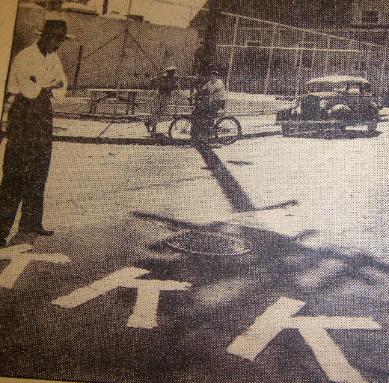
The intersection of Homer and Ramona where a KKK insignia was painted in 1946. The man in the photo is unidentified.
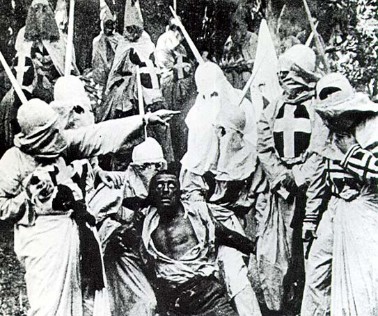
The Klan seeking revenge on black-faced "Gus" in The Birth of the Nation.
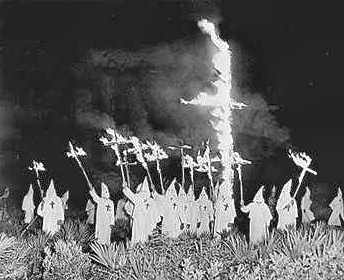
Burning crosses and ghost-like outfits remain a memory of the Klan.
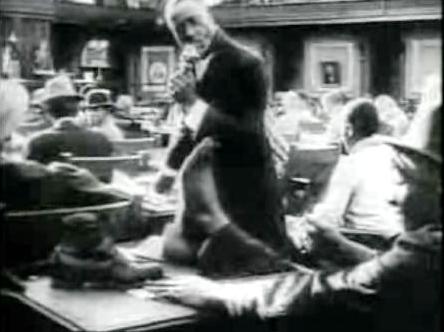
InThe Birth of a Nation, black legislators are pictured with their feet on the desks and eating friend chicken.
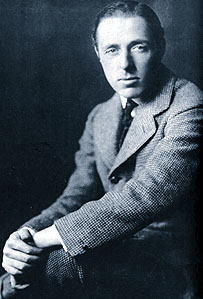
D.W. Griffith, director of The Birth of a Nation.
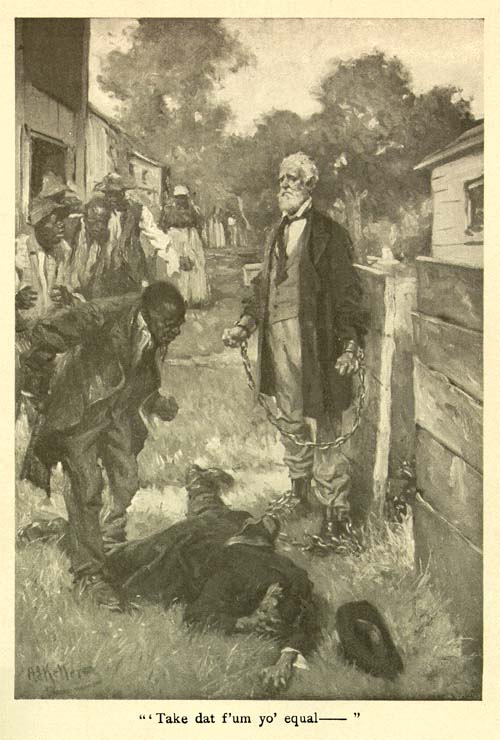
A scene from the book, The Clansman by Thomas Dixon.
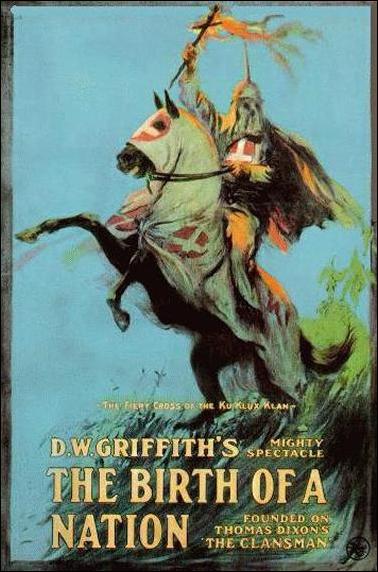
The film poster for The Birth of a Nation.